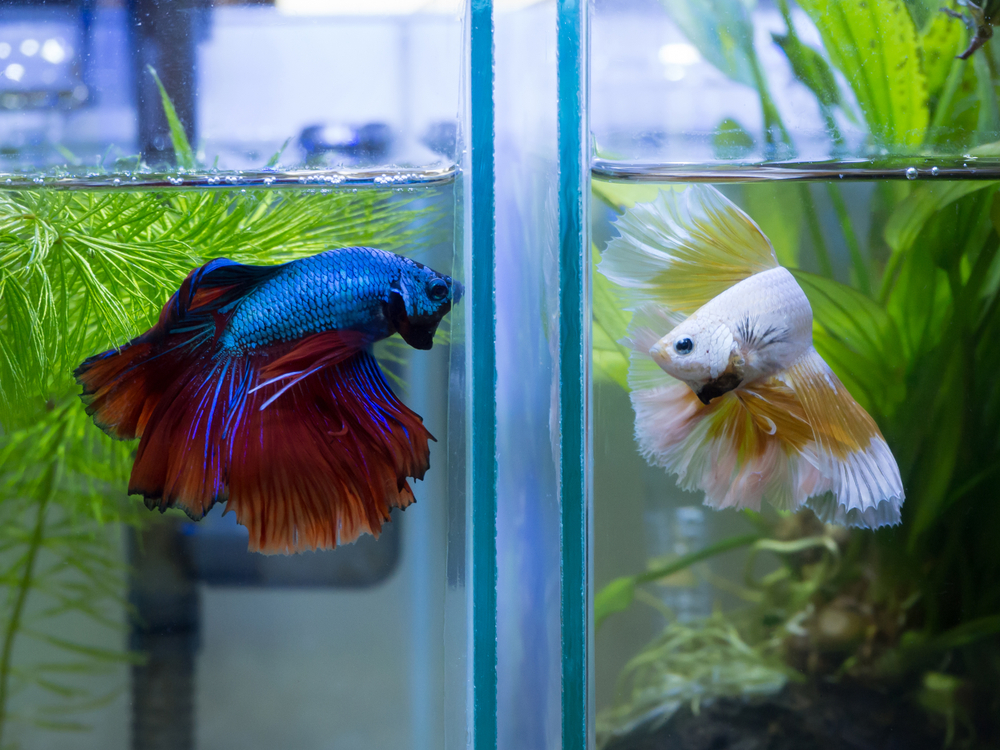Bettas are a famously territorial species. They’re not very eager to share their space with others, especially if “others” are fish that share their temperament. Still, as an aquarist, you have almost certainly wondered if you can’t have two bettas in the same tank—one male, one female.
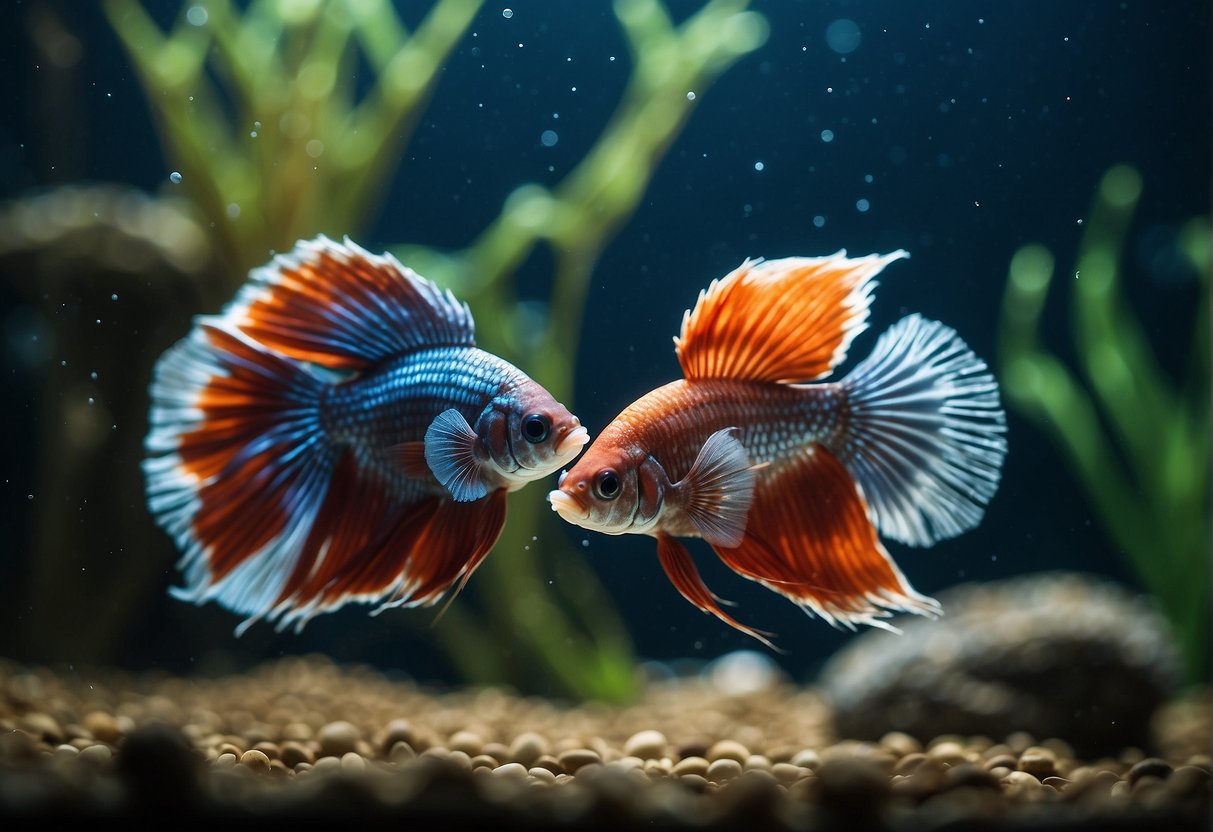
You wouldn’t be wondering outlandishly; after all, the males and females of the species are different enough in temperament that it’s possible they can cohabit. So, is it sustainable to have male and female bettas live together?
This article will answer that question comprehensively, drawing from my experience as a community aquarist and all other human fish-keeping know-how. Read on.
Contents
Understanding Betta Fish
Betta fish might be small, but they have a whole world inside their heads that you can glimpse from their external behaviors. Before you put two such betta worlds in a shared tank, you need to understand them.
A betta fish has a bit of an ego; how big is that ego? What’s it all about? Can a single tank contain two of them? Let’s dive into the mental world of bettas and answer these questions.
Territorial Nature and Social Behaviour
Remember that ego I just mentioned Bettas having? It’s partly for territorial protection, wherein the bettas put on an aggressive dominance display to ward off potential invaders of their space.
They tend to display such displays when the invader is another male of the same or different species. Such touchiness about infringement on their territory basically makes betta fish solitary creatures, socially speaking, and this is true for all known betta varieties.
Unsurprisingly, male bettas tend to be far less aggressive toward female members of their species. They can display aggression towards the females if provoked or uncomfortable by unfavorable tank conditions.
Still, the most usual kind of aggression the male will display towards the female is less of a scare tactic and more of an attempt to impress her for mating purposes.
All that aggression aside, when the environmental conditions are right and the tankmates stay out of their way, betta fish are still very capable of co-existing peacefully with tankmates—even female members of their species.
Aquarium Setup
Now that we know male and female bettas can live in the same tank, it’s time to get into the nitty-gritty of making that work. The starting point is to have the proper aquarium setup for peaceful coexistence.
Tank Requirements
Betta fish are not fun to be around when they feel like sardines. They may vent their frustration on the nearest moving organism in that cramped space. To prevent such aggressive spark-outs, you need to get the aquarium right.
Start with the aquarium size. A volume of up to 5 gallons is ideal for a single betta, but you need at least 10 gallons when you have two. This size offers enough room for both fish to swim and live without getting in each other’s way.
Water Conditions

Water conditions are also significant factors in ensuring peaceful coexistence between two bettas. These organisms thrive in warm, stable water.
Keeping the water temperature between 76°F and 80°F (24°C —26°C), the pH levels between 6.5 and 7.5, the ammonia and nitrite levels at 0 ppm, and the nitrates as low as possible (definitely below 20 ppm) works wonders for me. Regular monitoring and water changes will help you maintain these parameters.
Aquarium Plants
Incorporating live plants into the aquarium enhances water quality, closely mimics the betta’s natural habitat, and makes your betta pair feel more at home. The best option for plant decor is dense foliage such as Java Fern or Anubias, which you can anchor to decorations or driftwood.
You can also leverage fast-growing species like Hornwort to help maintain good water quality by absorbing excess nutrients.
Introducing Bettas
You may bring a new betta to a right-sized aquarium with only one existing occupant or a new pair to an uninhabited tank. Either way, one or both fish have to be acclimated to a new environment, and bungling the exercise may leave you with two very testy fish on your hands.
It’s important to acclimate them properly and monitor their interactions closely upon introduction to ensure a peaceful cohabitation. So, let’s talk about how to do it right.
Acclimating Bettas
The water quality is the first thing you need to acclimate your betta to. Instead of introducing them to the water abruptly, you need to gradually get them used to it. The best way to do this is to float their separate containers in the tank to equalize the temperature.
After about 15 minutes, you can incrementally add small amounts of tank water to their containers over an hour. This gradual process helps minimize the shock and stress that they may experience due to sudden changes in water conditions.
Coexistence Strategies
Creating harmonious living conditions for male and female betta fish calls for proactive, tailored coexistence strategies. Let’s discuss some of those.
Creating Dividers
While male and female betta fish can coexist in the same tank if the conditions are right, they are still prone to falling out with each other sometimes. Besides, exact temperament varies between individuals, and no two pairs of betta fish will necessarily coexist to the same degree.
Using tank dividers, you can reduce the odds of both fish having a quarrel. Your tank divider must be made of a material that allows water flow but is opaque so that the fish don’t see each other.
Betta Fish Care
With living arrangements in order for your male and female bettas, you now have to ensure adequate care for both. A tank divider already prevents them from seeing or reaching each other, so there’s less chance of them turning their aggression on one another when the care is poor.
Still, regardless of whether you use a tank divider or not, adequate care remains a great way to ensure your betta fish remain affable.
Feeding Routine
You should follow the same well-ordered feeding routine for both fish. Here’s how you can structure their feeding.
- Daily Feeding: I feed my Bettas high-quality pellets specifically designed for them. Since Bettas are carnivorous, these pellets typically contain fish or shrimp meal, which meets their nutritional needs.
- Portion Size: It’s important to feed them the right amount. Two pellets, twice a day, are usually sufficient to keep them well-fed without overfeeding.
- Variety is Key: Once or twice a week, I alternate the main diet with frozen or live food like bloodworms or brine shrimp, which provides essential nutrients and keeps my Bettas active.
- Fasting Days: I implement one fasting day per week to prevent constipation and bloating, as Bettas can often overeat if given the chance.
Health Monitoring
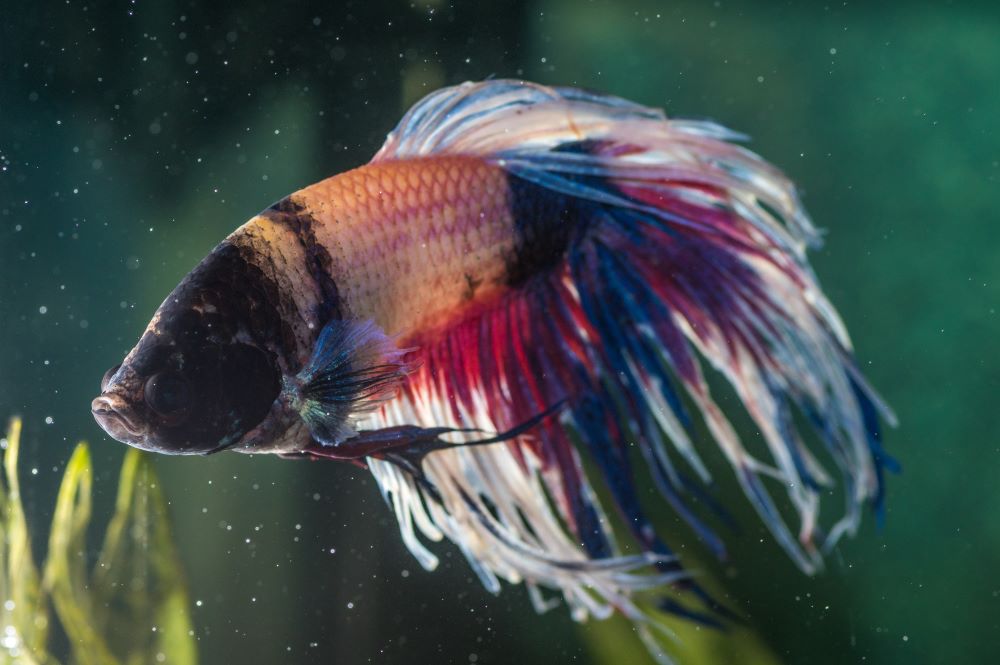
Betta fish can show signs of stress and disease, which you must watch closely. Here’s how you can keep track:
- Tank Cleaning: Maintain a clean tank environment, as dirty water can lead to high stress and health issues. You should also perform partial water changes weekly, ensuring that about 25-30% of the water is refreshed.
- Stress Indicators: You must look for signs of stress, such as faded color, clamped fins, and lethargy. Stress can lower their immune response, so take immediate action if you notice these symptoms.
- Disease Prevention: Regular monitoring helps catch diseases like fin rot or ich early before they cause major trouble. At the first sign of illness, you should assess your Betta’s condition and adjust the water parameters or begin appropriate treatment.
Frequently Asked Questions
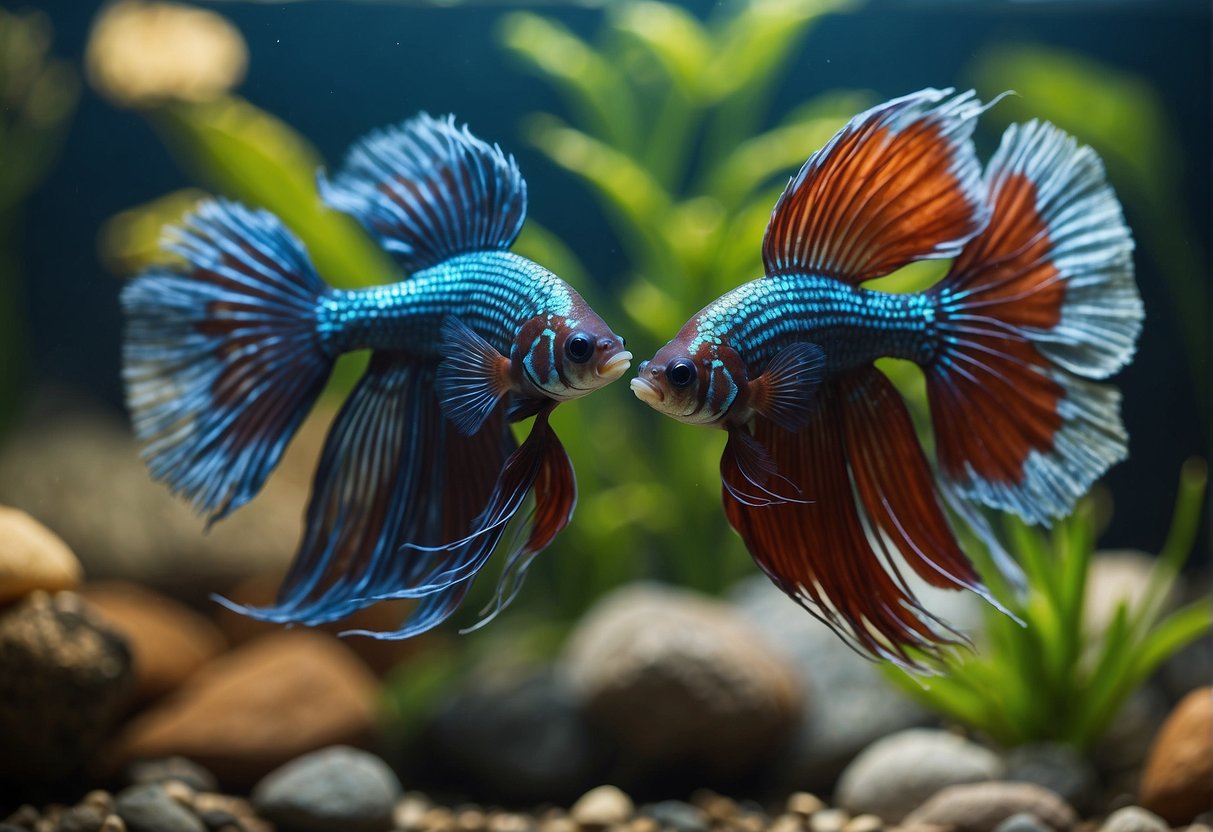
So, you’re wondering if male and female bettas can share a tank. Well, here are some answers to questions many fish keepers have about that.
What tank conditions are necessary to house male and female betta fish together?
To house a male and female betta fish together, you should ensure a spacious tank—ideally a 40-gallon minimum—to afford them enough territory and reduce potential aggression. The tank must have plenty of hiding spots and be heavily planted to mimic their natural habitat.
How should betta fish be introduced to establish cohabitation in a tank?
When introducing betta fish to establish cohabitation, a cautious approach of keeping them in adjacent tanks is ideal. It allows visibility without physical contact. You may then gradually introduce the female into the male’s tank or vice versa, closely monitoring their interaction.
What are the signs of aggression between male and female betta fish when housed together?
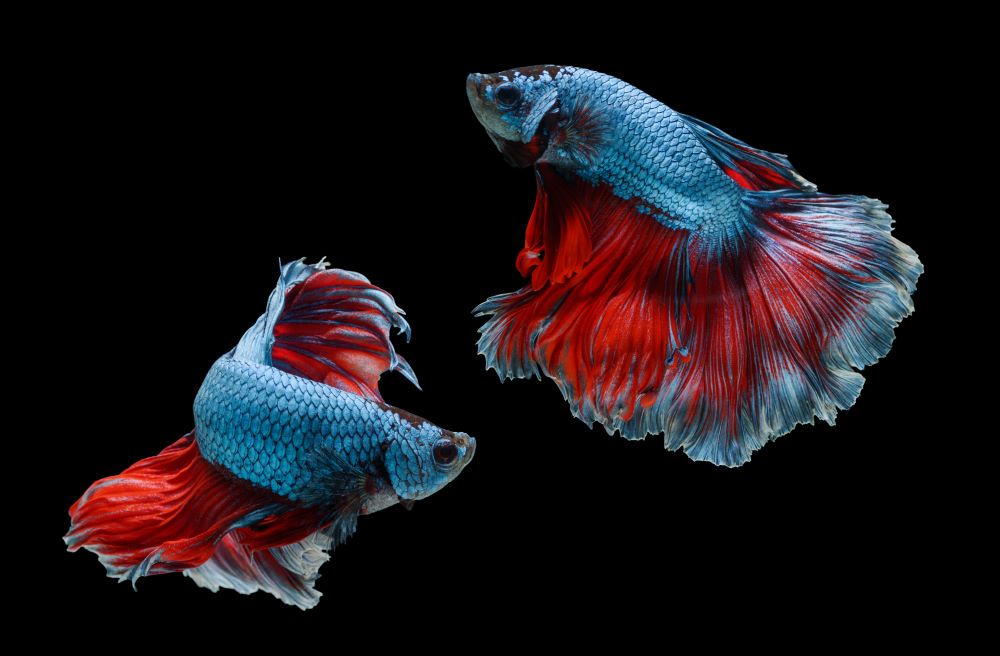
Common signs of aggression to look for include flaring, biting, and chasing. If these behaviors are persistent, it indicates that the bettas are incompatible with cohabitation and should be separated to prevent injury.
Can betta fish of opposite genders coexist without breeding, and if so, how?
Male and female betta fish can temporarily coexist without breeding, especially in larger tanks with ample space and environmental enrichment. However, you should always be prepared to separate them if you notice signs of breeding behavior that could lead to stress or aggression, especially if you do not intend to breed them.
What species are compatible with cohabiting with male and female betta fish in a community tank?
In a community tank, you need peaceful species that do not nip fins or compete aggressively for territory. Some compatible species include small tetras, corydoras, and snails, which tend to live peacefully with bettas.
How can you minimize conflict risk between a male and multiple female betta fish?
To minimize the risk of conflict when keeping a male with multiple females, known as a betta harem, provide a very large tank with complex structures and multiple hiding spaces. This allows each betta to establish its own territory and reduces encounters that can lead to aggression.

Ian Sterling, founder of Fishlab.com, began his aquarium journey over 30 years ago, driven by a deep fascination for fish and their diverse personalities. His website, Fishlab.com, is dedicated to making fishkeeping accessible and enjoyable, offering beginner-friendly guidance, expert insights, and a community for aquarists to connect and share experiences.


